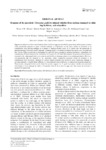Por favor, use este identificador para citar o enlazar este ítem:
http://www.alice.cnptia.embrapa.br/alice/handle/doc/470670Registro completo de metadatos
| Campo DC | Valor | Lengua/Idioma |
|---|---|---|
| dc.contributor.author | MORAES, M. C. B. | pt_BR |
| dc.contributor.author | PAREJA, M. | pt_BR |
| dc.contributor.author | LAUMANN, R. A. | pt_BR |
| dc.contributor.author | HOFFMANN-CAMPO, C. B. | pt_BR |
| dc.contributor.author | BORGES, M. | pt_BR |
| dc.date.accessioned | 2014-01-22T22:20:55Z | - |
| dc.date.available | 2014-01-22T22:20:55Z | - |
| dc.date.created | 2008-04-14 | pt_BR |
| dc.date.issued | 2008 | pt_BR |
| dc.identifier.citation | Journal of Plant Interactions, v. 3, n. 2, p. 111-118, June 2008. | pt_BR |
| dc.identifier.uri | http://www.alice.cnptia.embrapa.br/alice/handle/doc/470670 | pt_BR |
| dc.description | Egg parasitoids have a short time frame in which their host eggs are suitable for parasitism, and in several systems these parasitoids respond to plant volatiles induced by oviposition on the plant (either in isolation or in combination with feeding damage) as a means of finding suitable hosts. It is known that the parasitoid of pentatomid eggs Telenomus podisi responds to damage done to soybeans by female Euschistus heros, its preferred host. ln this study our aim was to determine the type of E. heros damage to soybean (herbivory, oviposition or a combination of both) necessary for attraction of T. podisi. ln a Y-tube olfactometer the parasitoid has shown to respond to the undamaged plant over clcan air and herbivory-damaged plants over undamaged plants. However, the parasitoids did not respond to the treatments wherc oviposition occurred, either in isolation or in combination with herbivory. Analysis of volatile blends revealed that herbivory plus oviposition damage to soybean induced a volatile blend different to those induced when herbivory or oviposition occurred separately. These results, along with other results from this system, suggest that T. podisi uses plant volatile cues associated with female E. heros damage in order to be present when E. heros lays its eggs, and thus ensure its resource is optimal for parasitism. | pt_BR |
| dc.language.iso | eng | eng |
| dc.rights | openAccess | eng |
| dc.title | Response of the parasitoid Telenomus podisi to induced volatiles from soybean damaged by stink bug herbivory and oviposition. | pt_BR |
| dc.type | Artigo de periódico | pt_BR |
| dc.date.updated | 2018-10-05T11:11:11Z | pt_BR |
| dc.subject.thesagro | Percevejo | pt_BR |
| riaa.ainfo.id | 470670 | pt_BR |
| riaa.ainfo.lastupdate | 2018-10-05 -03:00:00 | pt_BR |
| dc.identifier.doi | 10.1080/17429140701810724 | pt_BR |
| dc.contributor.institution | MARIA CAROLINA BLASSIOLI MORAES, CENARGEN; MARTIN PAREJA; RAUL ALBERTO LAUMANN, CENARGEN; CLARA BEATRIZ HOFFMANN-CAMPO, CNPSO; MIGUEL BORGES, CENARGEN. | pt_BR |
| Aparece en las colecciones: | Artigo em periódico indexado (CNPSO)  | |
Ficheros en este ítem:
| Fichero | Descripción | Tamaño | Formato | |
|---|---|---|---|---|
| ResponseoftheparasitoidTelenomuspodisitoinducedvolatilesfromsoybeandamagedbystinkbugherbivoryandovipostion.pdf | 277.78 kB | Adobe PDF |  Visualizar/Abrir |









